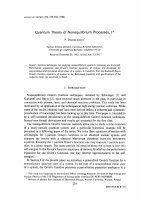Quantum theory of absorption of electromagnetic wave in two-dimensional graphene
Bạn đang xem bản rút gọn của tài liệu. Xem và tải ngay bản đầy đủ của tài liệu tại đây (1.12 MB, 10 trang )
TẠP CHÍ KHOA HỌC − SỐ 31/2019
107
QUANTUM THEORY OF ABSORPTION
OF ELECTROMAGNETIC WAVE
IN TWO - DIMENSIONAL GRAPHENE
Nguyen Vu Nhan1, Tran Anh Tuan2, Do Tuan Long2, Nguyen Quang Bau2
1
Hanoi Metropolitan University
2
Hanoi University of Science
Abstract: Quantum theory of absorption of electromagnetic wave (EMW) by confined
electrons in two - dimensional (2D) graphene has been studied by using the quantum
kinetic equation in assumption of electron - optical phonon scattering. The analytic
expression of absorption coefficient is obtained in 2D graphene. The results in this case
are compared with the case of the bulk semiconductors show the difference and the
novelty of the results. The results numerically calculated and graphed show the
dependence of absorption coefficient on the frequency of the electronmagnetic wave, the
temperature of the system and characteristic parameters of 2D graphene.
Keywords: Absorption coefficient, Quantum kinetic equation, 2D Graphene, confined
electron, Electron - phonon scattering, Electromagnetic wave.
Email:
Received 27 March 2019
Accepted for publication 25 May 2019
1. INTRODUCTION
In recent years, 2D Graphene has been used extensively in electronic devices. This has
led to a revolution in science and technology. Therefore, researching on graphene materials
becomes scientists’s interest. One of the recent studies of graphene materials is
Magnetophonon Resonance in Graphene monolayers. Specifically, the author Borysenko
K. M. [1] investigated the process of electron-phonon interaction in graphene. The author
Deacon R. S. and colleagues [2] studied cyclotron resonance to determine the velocity of
electrons and holes in single-layer graphene. Or the author group Mori N. and Ando T. [3]
have studied magnetic-phonon resonance in Graphene monolayers by using Kubo formula.
However, the problem of absorption of the electromagnetic wave in the case of the
presence of an external magnetic field in 2D Graphene has not been studied, so, in this
work, we used the quantum kinetic equation method to calculate the nonlinear absorption
TRƯỜNG ĐẠI HỌC THỦ ĐÔ H
108
NỘI
coefficient in 2D Graphene under the influence of electromagnetic wave. We saw some
differences between the results obtained in this case and in the case of the bulk
semiconductors. Numerical calculations are carried out with a specific 2D Graphene. And
the final section show remarks and conclusions.
2. NONLINEAR ABSORPTION COEFFICIENT IN THE CASE OF THE
PRESENCE OF AN EXTERNAL MAGNETIC FIELD
In this report, we use quantum kinetic equation method to obtain nonlinear absorption
coefficient in 2D Graphene in the presence of electromagnetic wave. We consider a 2D
Graphene subjected to a static magnetic field B = (0; 0; B) is perpendicular to the system.
The wave function and the corresponding energy [4] are given by the formula below:
,
(1)
with:
,
(2)
where L is the linear dimension of the system, X is a center coordinate, Hn(t) is Hermite
polynomial, ℓ =
cℏ
and n = 0; ±1; ....
eB
ε n = sgn(n)ℏωB n ,
(3)
with effective magnetic energy given by:
ℏω B =
2
γ.
ℓ
(4)
The Hamiltonian of the electron - optical phonon systein 2D Graphene in the second
quantization presentation can be written as:
,
(5)
TẠP CHÍ KHOA HỌC − SỐ 31/2019
109
where: εn is energy of electron (3), A(t ) is the vector potential of an external
electromagnetic wave, n denotes the quantization of the energy spectrum in the z direction
(n = 1, 2, 3, ...);
respectively are wave vectors of electron, phonon,
k, q
(n, k ⊥ ), (n ', k ⊥ + q ⊥ ) are electron states before and after scattering, respectively, k ⊥ is in
plane (x,y) wave vector of the electron. an+, k ⊥ , an,k ⊥ , bq+ , bq are the creation and annihilation
operators of electron,phonon, respectively, q = (q ⊥ , qz ) ; M n, n ' (q) is the matrix factor of
electron, given by:
,
2
2
with: C (q ⊥ ) = ℏD2op
2ρL ωq
(6)
is the electron { optical phonon interaction constant, ρ = 7:7 × 10-8
g/cm2 is mass density of 2D Graphene, Dop =1:4 × 10-9 eV/cm is deformed potential of
optical phonon.
,
(7)
2 2
with Lmj (u) is the associated Laguerre polynomial, u = ℓ q , q 2 = qx2 + q 2y ,
2
m = min( n , n ' ), j = n − n ' , S n ≡ sng ( n ).
(8)
2.1. Quantum kinetic equation for electron in 2D Graphene
When a high-frequency electromagnetic wave is applied to the system in the z
direction with electric field vector E = E 0 sin Ωt (where E 0 and Ω are the amplitude and
the frequency of the electromagnetic wave), the quantum kinetic equation of average
number of electron nn, k ⊥ = an+,k ⊥ an,k ⊥ is:
iℏ
∂ an+, k ⊥ an,k ⊥
∂t
t
= an+,k ⊥ an ,k ⊥ , H
t
.
(9)
Starting from the Hamiltonian (5) and using the commutative relations of the creation
and the annihilation operators, we obtain the quantum kinetic equation for electrons in 2D
Graphene:
TRƯỜNG ĐẠI HỌC THỦ ĐÔ H
110
,
NỘI
(10)
It is well known that to obtain the explicit solutions from (10) is very difficult. In this
paper, we use the first-order tautology approximation method to solve this equation. In
detail, in (10), we use the approximation:
where nn,k is the time - independent component of the electron distribution function. The
⊥
approximation is also applied for a similar exercise in bulk semiconductor [5, 6]. We
perform the integral with respect to t. Next, we perform the integral with respect to t of
(10). The expression of electron distribution function can be written as:
where N q is the time-independent component of the phonon distribution function, Jk (x) is
the Bessel function and the quantity δ is infinitesimal and appears due to the assumption of
an adiabatic interaction of the electromagnetic wave.
2.2. Calculation of nonlinear absorption coefficient in 2D Graphene
The carrier current density formula in 2D Graphene takes the form:
TẠP CHÍ KHOA HỌC − SỐ 31/2019
111
.
Because the motion of electrons is confined along the z direction in a 2D Graphene,
we only consider the in plane (x, y) current density vector of electrons J ⊥ (t ) . Using (11),
we find the expression for current density vector:
,
(12)
here:
,
(13)
By using the matrix factor, the electron - optical phonon interaction factor in (6) and
the Bessel function [7, 8], from the expression for the current density vector (12) we
establish the nonlinear absorption coefficient of the electromagnetic wave:
,
(14)
where X
t
means the usual thermodynamic average of X at moment t, and χ1 is the high-
frequency dielectric constants, δ(x) is the Dirac delta function. For simplicity, we limit the
problem to case of ℓ = 0, ℓ = 1 :
.
(15)
Let consider the electron - optical phonon interaction when the temperature of the
system is high (T > 50K), the electron - optical phonon interaction is higher than other
interactions. In this case, electron gas is assumed that non-generated gas and abided by the
Boltzmann distribution. Simultaneously, let assume that phonon is not dispersive, means,
ω0 = const. const is the optical phonon frequency non-dispersion:
,
(16)
TRƯỜNG ĐẠI HỌC THỦ ĐÔ H
112
Nq
eq
NỘI
is the equilibrium distribution function of phonons. By replacing (16), (15) on
(14), change k ⊥ + q ⊥ → n, k ⊥ → n ' in Dirac delta function, denote nk = f n ,k ⊥ we get the
absorption coefficient :
,(17)
Transforming the summations over q⊥ and k ⊥ to integrals as follows:
.
(18)
The expression (17) becomes:
.
(19)
We use the calculation results in [9]:
.
(20)
Finally, inserting (20) into (19) we obtain the explicit expression for the absorption
coefficient as:
.
(21)
The delta functions in (21) are divergent as their arguments equals to zero. To avoid
this, we replace them phenomenology by Lorentzians as [10]:
δ(ε ) =
ΓΚ
π(ε 2 + Γ 2Κ )
, where Γ Κ = ℏωB WΚ is the level width, WΚ =
dimensionless parameter characterizing the scattering strength.
ℏDop2
8πργ 2ωΚ
is the
TẠP CHÍ KHOA HỌC − SỐ 31/2019
113
3. NUMERICAL RESULTS AND DISCUSSION
In order to clarify the mechanism for the nonlinear absorption of a electromagnetic
wave in 2D graphene, in this section, we will evaluate, plot and discuss the expression of
the nonlinear absorption coefficient for the case of a special 2D Graphene. We use some
results for linear absorption in [11] to make the comparison between the linear and the
nonlinear absorption phenomena. For this section, the parameters used in computational
calculations are as follows [3, 10] in Table I:
3.1. The dependence of absorption coefficient on temperature
Fig 1. The dependence of α on T
Figure 1 shows the dependence of the nonlinear absorption coefficient α on the
temperature T of the system at different values of the magnetic field. It can be seen from
this figure that the nonlinear absorption coefficient α depends strongly and non-linearly on
T. We can see that non-linear absorption coefficient reaches at the saturated value when
temperature is very low and increases quickly when temperature is high.
114
TRƯỜNG ĐẠI HỌC THỦ ĐÔ H
NỘI
Therefore, the presence of electromagnetic wave influence on the absorption
coefficient is quite remarkable, the absorption coefficient value is the same in domain of
low temperature and have different values in the region with higher temperatures. This
result is consistent with those previously reported by using Boltzmann kinetic equation in
other two-dimensional systems [12]. This coefficient absorption is the same as the results
which gained in bulk semiconductor. The smaller magnetic the smaller absorption
coefficient. When B is high, the absorption increases.
3.2. The dependence of absorption coefficient on magnetic field
In figure 2 the dependence of absorption coefficient in case electron - optical phonon
scattering on magnetic is non-linear. As can be seen, form the graph, in each case of the
magnetic field, the absorption coefficient reaches a peak with the specific value of
electromagnetic wave frequency Ω. When magnetic field value increases, absorption
coefficient at the peak position tends to upwards.
Fig 2. The dependence of α on B
3.3. The dependence of absorption coefficient on the frequency of
electromagnetic wave
In figure 3 the dependence of absorption coefficient on frequency electromagnetic
wave at presence on magnetic field, at three different magnetic field points. In this case,
absorption peak is so sharp and absorption coefficient has significant value when near
absorption peak. From the graph, we see that the oscillations have appeared and oscillation
is controlled by the ratio of the Fermi energy and the cyclotron energy. The mechanism of
the oscillations can be easily explained as follows. At low temperature and strong magnetic
field, the free electrons in 2D Graphene will move as simple harmonic oscillator. When the
magnetic field changes, the cycle of the oscillations also change. The energy levels of
electrons are separated into Landau level, with each Landau level, cyclotron energy, and
the electron state linearly increase with the magnetic field. When the energy level of the
Landau levels excesses the value of Fermi level, the electron can move up freely and move
TẠP CHÍ KHOA HỌC − SỐ 31/2019
115
in the line, which makes the absorption coefficient oscillate circulating with the magnetic
field. That means the external magnetic has a significant effect on absorption coefficient,
the transfer energy level of electron after absorption electromagnetic wave must satisfy
condition Ω − ω0 = 0 . This result is one of the new findings that we have studied.
Fig 3. The dependence of α on Ω
4. CONCLUSION
In this paper, by using quantum kinetic equation, we anlytically calculated the
absorption coefficient in 2D Graphene under the influence of weak electromagnetic wave.
After obtained the analytical expression of absorption coefficient by electrons confined in
2D Graphene for the presence of an external magnetic field, we graphed them numerically
to clarify the dependence of absorption coefficient on the frequency Ω of the
electromagnetic wave, the temperature T of the system, the magnetic field B. The
coefficient absorption in graphene is the same as the results which gained in bulk
semiconductor. It is found in this paper that the absorption coefficient oscillates when the
electromagnetic wave frequency changes. At each specific point of magnetic field,
absorption coefficient reaches peaks and oscillates with different amplitudes. The stronger
magnetic field is, the higher peaks are. Moreover, in this paper, we used the quadratic
approximation of the Bessel function to eliminate the influence of electromagnetic wave
intensity on the nonlinear absorption coefficient to simplify the problem. However,
calculations in the 2D Graphene are still much more complicated than calculating weak
electromagnetic wave non-linear absorption coefficients in other two-dimensional systems
like quantum wells, doped superlattices by Kubo - Mori method [13, 14].
TRƯỜNG ĐẠI HỌC THỦ ĐÔ H
116
NỘI
REFERENCES
1.
K. M. Borysenko, J. T. Mullen, E. A. Barry, S. Paul, Semenov, and K. W. Kim (2010), “Firstprinciples analysis of electron-phonon interactions in graphene”, - Phy. Rev B., Vol. 81, No.
12, pp. 3-6.
2.
R. S. Deacon, K. Chuang, R. J. Nicholas, K. S. Novoselov, and A. K. Geim (2007),
“Cyclotron resonance study of the electron and hole velocity in graphene monolayers”, - Phy.
Rev. B, pp. 2-5.
3.
N. Mori and T. Ando (2011), “Magnetophonon resonance in monolayer graphene”, - J. Phys.
Soc. Jpn, Vol. 80, No. 4.
4.
T. Ando (2007), “Magnetic oscillation of optical phonon ingraphene”, - J. Phys. Soc. Jpn, Vol.
76, No. 2.
5.
E. M. Epstein (1975), Sov. Communicacattion of HEE of USSR, Ser, p.785.
6.
V. L. Malevich and E. M. Epstein (1974), Sov. Quantum Electronic 1, p.1468.
7.
G. B. Arfken, H. J. Weber, and F. E. Harris (2013), Mathematical Methods for Physicists.
8.
H. B. Dwight (2006), Tables of Integrals and Other Mathematical Data., Vol.50. JSTOR.
9.
L. T. Phuong, T. M. Duyen, V. T. Lam, and B. D. Hoi (2017), “Investigation of Magnetophonon Resonance in Graphene Monolayers”, - VNU Journal of Science: MathematicsPhysics, Vol.33, No.4, pp.45-56.
10. H. V. Phuc, N. N. Hieu, L. Dinh, and T. C. Phong (2015), “Nonlinear optical absorption in
parabolic quantum wellvia two-photon absorption process”, - Optics Communications,
Vol.335, pp.37-41.
11. N. Q. Bau, N. V. Nhan, and T. C. Phong (2002), “Calculations of the absorption coefficient of
a weak electromagnetic wave by free carriers in doped superlattices by using the Kubo-Mori
method”, - J. Kor. Phys. Soc., p.149.
12. Shik (1999), Quantum wells in Physics and Electronics oftwo-dimensional systems.
13. N. Q. Bau and T. C. Phong (1998), “Calculations of the absorption coefficient of a weak emw
by free carriers in quantum wells by the kubo-mori method”, - J. Phys. Soc. Jpn.
LÝ THUYẾT LƯỢNG TỬ HẤP THỤ SÓNG ĐIỆN TỪ
TRONG GRAPHENE HAI CHIỀU
Tóm tắ
tắt: Nghiên cứu lý thuyết lượng tử hấp thụ sóng điện từ (EMW) trong Graphene hai
chiều (2D) bằng phương trình động lượng tử với giả thiết cơ chế tán xạ electron-phonon
quang. Thu được biểu thức giải tích cho hệ số hấp thụ trong Graphene 2D. Các kết quả
là mới và được so sánh với trường hợp trong bán dẫn khối để thấy sự khác biệt. Kết quả
thu nhận được tính số và vẽ đồ thị biểu thị sự phụ thuộc của hệ số hấp thụ vào tần số
EMW, nhiệt độ của hệ và các tham số đặc trưng cho Graphene 2D.
Từ khóa: Hệ số hấp thụ, phương trình động lượng tử, 2D Graphene, electron giam cầm,
tán xạ electron-phonon, sóng điện từ.









